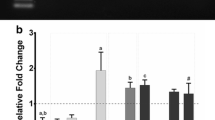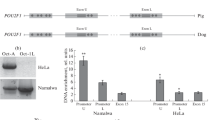Abstract
We previously showed that the −278 to +410 region of mouse thymosin β4 (mTβ4) gene supports high levels of reporter gene expression in NIH3T3 cells. This region contains part of the 5′-flanking sequences (−278 to −1), the intact first exon (+1 to +133), and portion of the first intron (+134 to +410). However, the size of this exon is much longer than those of its rat and human counterparts. To resolve the question regarding this size discrepancy, transcription start site for the mTβ4 gene was re-examined by primer extension and bioinformatics analyses. We found that the first exon of mTβ4 gene spans 56 bp with its cap site situated in a putative initiator highly similar to the consensus mammalian sequence. In addition, a TATA box-like motif and two consecutive downstream promoter elements were also found. To delineate the cis-elements involved in modulating the constitutive expression of mTβ4 gene, transient transfection assay was performed. Interestingly, expression level of the reporter gene driven by the −117 to +56 region of mTβ4 gene was approximately 8-fold higher than that directed by the SV40 promoter and significant promoter activity was found to be associated with the smaller (−56 to +56) fragment. A nuclear protein-bound silencer was located in the region between the −167 and −118 and an enhancer whose effect did not seem to be dependent on protein binding was identified in the downstream (−117 to −88) region. However, neither of these cis-elements affected reporter expression driven by a SV40 promoter. Intriguingly, mTβ4 promoter functioned well in human colorectal (SW480) and cervical (HeLa) carcinoma cells. Taken together, our findings not only provide crucial information for further elucidation of the transcriptional regulation of mTβ4 gene but also raise the possibility of utilizing its promoter to produce large quantity of recombinant proteins in mammalian cells.
Similar content being viewed by others
References
Huff T, Muller CS, Otto AM, Netzker R, Hannappel E: Beta-Thymosins, small acidic peptides with multiple functions. Int J Biochem Cell Biol 33: 205–220, 2001
Safer D, Elzinga M, Nachmias VT: Thymosin beta 4 and Fx, an actin-sequestering peptide, are indistinguishable. J Biol Chem ([0-9]+): 4029–4032, 1991
Carlier MF, Jean C, Rieger KJ, Lenfant M, Pantaloni D: Modulation of the interaction between G-actin and thymosin beta 4 by the ATP/ADP ratio: Possible implication in the regulation of actin dynamics. Proc Natl Acad Sci USA 90: 5034–5038, 1993
Moscinski LC, Naylor PH, Oliver J, Goldstein AL: Thymosin beta 4 synergizes with human granulocyte-macrophage colony-stimulating factor in maintaining bone marrow proliferation. Immunopharmacology 26: 83–92, 1993
Philp D, Nguyen M, Scheremeta B, St-Surin S, Villa AM, Orgel A, Kleinman HK, Elkin M: Thymosin beta4 increases hair growth by activation of hair follicle stem cells. FASEB J 18: 385–387, 2004
Elitsur Y, Mutchnick MG, Sakr WA, Luk GD: Thymosin alpha 1 and thymosin beta 4 modulate human colonic lamina propria lymphocyte function. Immunopharmacology 20: 89–96, 1990
Bonnet D, Lemoine FM, Frobert Y, Bonnet ML, Baillou C, Najman A, Guigon M: Thymosin beta4, inhibitor for normal hematopoietic progenitor cells. Exp Hematol 24: 776–782, 1996
Malinda KM, Goldstein AL, Kleinman HK: Thymosin beta 4 stimulates directional migration of human umbilical vein endothelial cells. FASEB J 11: 474–481, 1997
Koutrafouri V, Leondiadis L, Avgoustakis K, Livaniou E, Czarnecki J, Ithakissios DS, Evangelatos GP: Effect of thymosin peptides on the chick chorioallantoic membrane angiogenesis model. Biochim Biophys Acta 1568: 60–66, 2001
Philp D, Huff T, Gho YS, Hannappel E, Kleinman HK: The actin binding site on thymosin beta4 promotes angiogenesis. FASEB J 17: 2103–2105, 2003
Cha HJ, Jeong MJ, Kleinman HK: Role of thymosin beta4 in tumor metastasis and angiogenesis. J Natl Cancer Inst 95: 1674–1680, 2003
Malinda KM, Sidhu GS, Mani H, Banaudha K, Maheshwari RK, Goldstein AL, Kleinman HK: Thymosin beta4 accelerates wound healing. J Invest Dermatol 113: 364–368, 1999
Philp D, Badamchian M, Scheremeta B, Nguyen M, Goldstein AL, Kleinman HK, Thymosin beta 4 and a synthetic peptide containing its actin-binding domain promote dermal wound repair in db/db diabetic mice and in aged mice. Wound Repair Regen 11: 19–24, 2003
Sosne G, Szliter EA, Barrett R, Kernacki KA, Kleinman H, Hazlett LD: Thymosin beta 4 promotes corneal wound healing and decreases inflammation in vivo following alkali injury. Exp Eye Res ([0-9]+): 293–299, 2002
Sosne G, Hafeez S, Greenberry AL II, Kurpakus-Wheater M: Thymosin beta4 promotes human conjunctival epithelial cell migration. Curr Eye Res 24: 268–273, 2002
Sosne G, Xu L, Prach L, Mrock LK, Kleinman HK, Letterio JJ, Hazlett LD, Kurpakus-Wheater M: Thymosin beta 4 stimulates laminin-5 production independent of TGF-beta. Exp Cell Res 293: 175–183, 2004
Al-Nedawi KN, Czyz M, Bednarek R, Szemraj J, Swiatkowska M, Cierniewska-Cieslak A, Wyczolkowska J, Cierniewski CS: Thymosin beta 4 induces the synthesis of plasminogen activator inhibitor 1 in cultured endothelial cells and increases its extracellular expression. Blood 103: 1319–1324, 2004
Girardi M, Sherling MA, Filler RB, Shires J, Theodoridis E, Hayday AC, Tigelaar RE: Anti-inflammatory effects in the skin of thymosin-beta4 splice-variants. Immunology 109: 1–7, 2003
Young JD, Lawrence AJ, MacLean AG, Leung BP, McInnes IB, Canas B, Pappin DJ, Stevenson RD: Thymosin beta 4 sulfoxide is an anti-inflammatory agent generated by monocytes in the presence of glucocorticoids. Nat Med 5: 1424–1427, 1999
Badamchian M, Fagarasan MO, Danner RL, Suffredini AF, Damavandy H, Goldstein AL: Thymosin beta(4) reduces lethality and down-regulates inflammatory mediators in endotoxin-induced septic shock. Int Immunopharmacol 3: 1225–1233, 2003
Tang YQ, Yeaman MR, Selsted ME: Antimicrobial peptides from human platelets. Infect Immun. 70: 6524–6533, 2002
Huff T, Ballweber E, Humeny A, Bonk T, Becker C, Muller CS, Mannherz HG, Hannappel E: Thymosin beta(4) serves as a glutaminyl substrate of transglutaminase. Labeling with fluorescent dansylcadaverine does not abolish interaction with G-actin. FEBS Lett 464: 14–20, 1999
Huff T, Otto AM, Muller CS, Meier M, Hannappel E: Thymosin beta4 is released from human blood platelets and attached by factor XIIIa (transglutaminase) to fibrin and collagen. FASEB J 16: 691–696, 2002
Blain EJ, Mason DJ, Duance VC: The effect of thymosin beta4 on articular cartilage chondrocyte matrix metalloproteinase expression. Biochem Soc Trans 30: 879–882, 2002
Li QY, Jones PL, Lafferty RP, Safer D, Levy RJ: Thymosin beta4 regulation, expression and function in aortic valve interstitial cells. J Heart Valve Dis 11: 726–735, 2002
Otero A, Bustelo XR, Pichel JG, Freire M, Gomez-Marquez J: Transcript levels of thymosin beta 4, an actin-sequestering peptide, in cell proliferation. Biochim Biophys Acta 1176: 59–63, 1993
Zalvide JB, Alvarez CV, Vidal A, Dieguez C, Vega FV, Dominguez F: Regulation of thymosin beta 4 mRNA levels during cell proliferation. Cell Prolif 28: 85–91, 1995
Schobitz B, Hannappel E, Brand K: The early induction of the actin-sequestering peptide thymosin beta 4 in thymocytes depends on the proliferative stimulus. Biochim Biophys Acta 1095: 230–235, 1991
Gomez-Marquez J, Franco del Amo F, Carpintero P, Anadon R: High levels of mouse thymosin beta4 mRNA in differentiating P19 embryonic cells and during development of cardiovascular tissues. Biochim Biophys Acta 1306: 187–193, 1996
Leonard DG, Ziff EB, Greene LA: Identification and characterization of mRNAs regulated by nerve growth factor in PC12 cells. Mol Cell Biol 7: 3156–3167, 1987
Atkinson MJ, Freeman MW, Kronenberg HM: Thymosin beta 4 is expressed in ROS 17/2.8 osteosarcoma cells in a regulated manner. Mol Endocrinol 4: 69–74, 1990
Shimamura R, Kudo J, Kondo H, Dohmen K, Gondo H, Okamura S, Ishibashi H, Niho Y: Expression of the thymosin beta 4 gene during differentiation of hematopoietic cells. Blood 76: 977–984, 1990
Lugo DI, Chen SC, Hall AK, Ziai R, Hempstead JL, Morgan JI: Developmental regulation of beta-thymosins in the rat central nervous system. J Neurochem 56: 457–461, 1991
Voisin PJ, Pardue S, Morrison-Bogorad M: Developmental characterization of thymosin beta 4 and beta 10 expression in enriched neuronal cultures from rat cerebella. J Neurochem 64: 109–120, 1995
Carpinterio P, Anadon R, del Amo FF, Gomez-Marquez J: The thymosin beta 4 gene is strongly activated in neural tissues during early postimplantation mouse development. Neurosci Lett 184: 63–66, 1995
Anadon R, Rodriguez Moldes I, Carpintero P, Evangelatos G, Livianou E, Leondiadis L, Quintela I, Cervino MC, Gomez-Marquez J: Differential expression of thymosins beta(4) and beta(10) during rat cerebellum postnatal development. Brain Res 894: 255–265, 2001
Vartiainen N, Pyykonen I, Hokfelt T, Koistinaho J: Induction of thymosin beta(4) mRNA following focal brain ischemia. Neuroreport ([0-9]+): 1613–1616, 1996
Carpintero P, Anadon R, Diaz-Regueira S, Gomez-Marquez J: Expression of thymosin beta4 messenger RNA in normal and kainate-treated rat forebrain. Neuroscience 90: 1433–1444, 1999
Clark EA, Golub TR, Lander ES, Hynes RO: Genomic analysis of metastasis reveals an essential role for RhoC. Nature 406: 532–535, 2000
Kobayashi T, Okada F, Fujii N, Tomita N, Ito S, Tazawa H, Aoyama T, Choi SK, Shibata T, Fujita H, Hosokawa M. Thymosin-beta4 regulates motility and metastasis of malignant mouse fibrosarcoma cells. Am J Pathol 160: 869–882, 2002
Su Y, Chang SL, Hsiao HL: Characterization of a 5′-flanking region supporting the transcription of mouse thymosin beta-4 in mouse NIH3T3 cells. Mol Cell Biochem 203: 163–167, 2000
Kanamoto R, Su Y, Pitot HC: Hormonal regulation of serine dehydratase gene expression in liver and kidney of the adrenalectomized rat. Mol Endocrinol 5: 1661–1668, 1991
Tang RY, Su Y: Construction of a cell-based high-flux assay for the rev protein of HIV-1. J Virol Methods 65:153–158, 1997
Singh H, Sen R, Baltimore D, Sharp PA: A nuclear factor that binds to a conserved sequence motif in transcriptional control elements of immunoglobulin genes. Nature 319:154–158, 1986
Li X, Zimmerman A, Copeland NG, Gilbert DJ, Jenkins NA, Yin HL: The mouse thymosin beta 4 gene: Structure, promoter identification, and chromosome localization. Genomics 32:388–394, 1996
Varghese S, Kronenberg HM: Rat thymosin beta 4 gene. Intron-containing gene and multiple retroposons. J Biol Chem 266:14256–14261, 1991
Yang SP, Lee HJ, Su Y: Molecular cloning and structural characterization of the functional human thymosin β-4 gene. Mol Cell Biochem (Accepted)
Smale ST, Kadonaga JT: The RNA polymerase II core promoter. Annu Rev Biochem 72: 449–479, 2003
Rudin CM, Engler P, Storb U: Differential splicing of thymosin beta 4 mRNA. J Immunol 144: 4857–4862, 1990
Brandeis M, Frank D, Keshet I, Siegfried Z, Mendelsohn M, Nemes A, Temper V, Razin A, Cedar H: Sp1 elements protect a CpG island from de novo methylation. Nature 371: 435–438, 1994
Prioleau MN, Nony P, Simpson M, Felsenfeld G: An insulator element and condensed chromatin region separate the chicken beta-globin locus from an independently regulated erythroid-specific folate receptor gene. EMBO J 18: 4035–4048, 1999
Author information
Authors and Affiliations
Corresponding author
Additional information
Sequence data from this article have been deposited with the EMBL/GenBank Data Libraries under Accession No. X99780.
Rights and permissions
About this article
Cite this article
Hsiao, HL., Su, Y. Identification of the positive and negative cis-elements involved in modulating the constitutive expression of mouse thymosin β4 gene. Mol Cell Biochem 272, 75–84 (2005). https://doi.org/10.1007/s11010-005-7638-0
Received:
Accepted:
Issue Date:
DOI: https://doi.org/10.1007/s11010-005-7638-0




